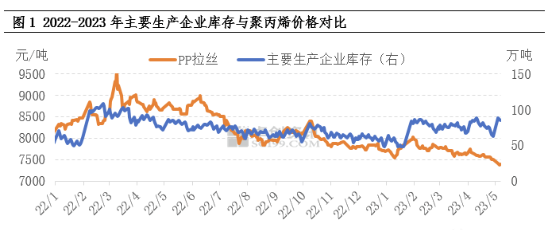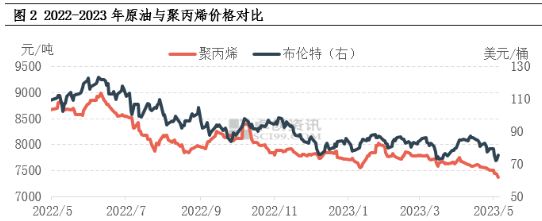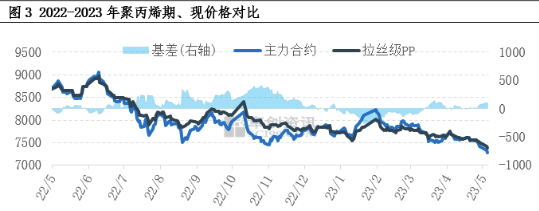Майга кирип, полипропилен апрель айында төмөндөөсүн улантты жана төмөндөөнү улантты, бул негизинен төмөнкү себептерден улам болгон: биринчиден, 1-Май майрамында ылдыйкы агымдагы заводдор токтоп калган же кыскарган, натыйжада жалпы суроо-талаптын олуттуу төмөндөшү, жогорку агымдагы өндүрүш ишканаларында инвентарлардын топтолушуна жана запастарды бошотуунун жай темпине алып келген; Экинчиден, майрам күндөрү чийки мунайдын баасынын тынымсыз төмөндөшү полипропиленге болгон чыгымдарды колдоону алсыратты, ошондой эле тармактын оперативдүү ой жүгүртүүсүнө олуттуу таасирин тийгизди; Мындан тышкары, PP фьючерстеринин фестивалга чейин жана андан кийинки начар иштеши спот базарынын баасын жана менталитетин төмөндөттү.
Сунуштун жана суроо-талаптын начардыгынан запастарды жок кылуунун жай темптери

Запастар суроо-талаптын жана сунуштун ар тараптуу өзгөрүүлөрүн чагылдырган салыштырмалуу интуитивдик көрсөткүч болуп саналат. Майрамга чейин, PP түзмөктөрдү тейлөө салыштырмалуу топтолгон, жана алдыңкы рыногунда спот сунушу тиешелүү түрдө кыскарган. Төмөнкү агымдагы заводдор жөн эле сатып алууга муктаж болгондуктан, кыска убакыттын ичинде кампага баруучу жогорку агымдагы өндүрүш ишканаларынын бурулуш чекити пайда болду. Бирок, ылдыйкы терминалдарды олуттуу керектөө канааттандырарлык эмес болгондуктан, кампага түшүүчү ишканалардын көлөмү салыштырмалуу чектелген. Кийинчерээк, майрам учурунда ылдый жактагы заводдор майрам күндөрү жабылып же алардын суроо-талаптарын азайтып, суроо-талаптын дагы кыскарышына алып келди. Майрамдан кийин негизги өндүрүш ишканалары PP запастарын олуттуу топтоо менен кайтып келишти. Ошол эле учурда, майрам мезгилинде чийки мунай баасынын кескин төмөндөшүнүн таасири менен бирге, майрамдан кийин базар соода маанайында олуттуу жакшыруу байкалган жок. Төмөнкү агымдагы заводдордо өндүрүшкө шыктануу аз болгон жана алар күтүшкөн же модернизациялоону тандашкан, натыйжада жалпы соода көлөмү чектелген. PP запастарын топтоо жана запастарды жок кылуу белгилүү басымы астында, ишкананын баасы акырындык менен төмөндөдү.
Мунайдын баасынын тынымсыз төмөндөшү чыгымдарды жана менталитетти колдоону алсыратат

Биринчи Май майрамында бүтүндөй эл аралык чийки мунай рыногунда олуттуу төмөндөө байкалды. Бир жагынан, Америка Банкынын окуясы дагы бир жолу тобокелдүү активдерди үзгүлтүккө учуратты, чийки мунай чийки зат рыногунда эң олуттуу төмөндөдү; Башка жагынан алганда, Федералдык Резерв пландалгандай пайыздык чендерди 25 базистик пунктка көтөрдү жана рынок дагы бир жолу экономикалык рецессия коркунучуна тынчсызданууда. Ошондуктан, пайыздык чендердин көтөрүлүшүнүн макро басымы астында банктык инцидент себеп болгон чийки мунай негизинен Сауд Аравиянын алгачкы этапта өндүрүштү активдүү кыскартуусу алып келген жогорулоо импульсун кайтарып алды. 2023-жылдын 5-майындагы жабылууга карата WTI бир баррелине 71,34 долларды түзүп, майрам алдындагы акыркы соода күнүнө салыштырмалуу 4,24%га төмөндөгөн. 2023-жылдын июль айында Brent баррели 75,3 долларды түзүп, майрам алдындагы акыркы соода күнүнө салыштырмалуу 5,33% төмөндөгөн. Мунайга болгон баанын тынымсыз төмөндөшү полипропиленге болгон чыгымдарды колдоону алсыратты, бирок, албетте, рыноктун маанайына олуттуураак таасир этет, бул рыноктун котировкаларынын төмөндөө тенденциясына алып келет.
Алсыз фьючерстердин төмөндөө тенденциясы Spot бааларды жана мамилелерди басат

Акыркы жылдары, полипропилен каржылык атрибуттары үзгүлтүксүз бекемделип, фьючерстер рыногу да полипропилен спот рыногуна таасир этүүчү маанилүү факторлордун бири болуп саналат. Фьючерстер рыногу төмөн өзгөрүп турат жана спот баанын түзүлүшү менен тыгыз байланышта. Базис боюнча айтсак, акыркы база оң болуп, майрамга чейин да, кийин да акырындап бекемделип калды. Сүрөттө көрсөтүлгөндөй, фьючерстердин төмөндөөсү споттук товарларга караганда көбүрөөк жана рыноктун төмөндөө күтүүсү күчтүү бойдон калууда.
Келечектеги рынокко келгенде, суроо-талап менен сунуштун негиздери дагы эле рыноктун багытына таасир этүүчү негизги фактор болуп саналат. Май айында дагы эле бир нече PP түзмөктөрүн техникалык тейлөө үчүн өчүрүү пландалууда, бул камсыздоо жагындагы басымды кандайдыр бир деңгээлде жеңилдетет. Бирок, ылдый агымдагы суроо-талаптын күтүлгөн жакшыруусу чектелүү. Кээ бир тармактык адистердин айтымында, ылдыйкы агымдагы заводдордун чийки заттык запасы жогору болбосо да, продукциянын алгачкы этабында запастардын көп топтолушу байкалат, андыктан негизги көңүл инвентаризацияга бурулат. Төмөнкү агымдагы терминалдык фабрикалардын өндүрүштүк шыктануусу жогору эмес жана алар чийки затка этияттык менен байкоо жүргүзүшөт, ошондуктан ылдыйкы агымдагы начар суроо-талап өнөр жай чынжырында суроо-талапты өткөрүүнүн чектелүү эффекттерине түздөн-түз алып келет. Жогорудагы талдоонун негизинде, полипропилен рыногу кыска мөөнөттө алсыз консолидацияны уланта берет деп күтүлүүдө. Этап-этабы менен позитивдүү жаңылыктар бааны бир аз көтөрөрү жокко чыгарылбайт, бирок жогору карай олуттуу каршылык бар.
Посттун убактысы: 2023-жылдын 10-майына чейин




